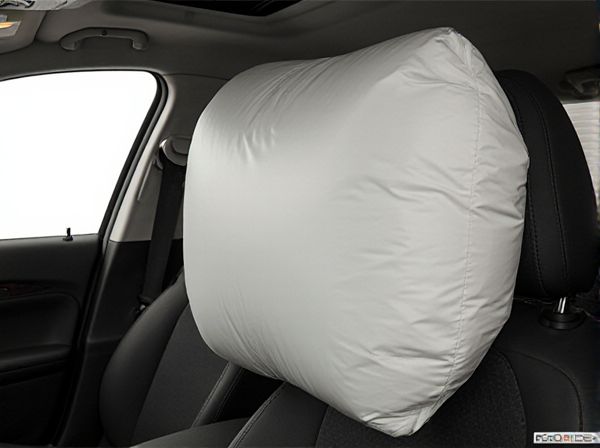
Photo illustration: Occupant Position Sensing vs Static
Occupant Position Sensing dynamically adjusts safety systems based on the real-time location of occupants, enhancing protection during collisions. Static sensing relies on fixed, pre-set positions, which may not accurately reflect occupant movement or posture. You benefit from improved airbag deployment and seatbelt tensioning with occupant position sensing, increasing overall vehicle safety.
Table of Comparison
| Feature | Occupant Position Sensing (OPS) | Static Airbag System |
|---|---|---|
| Function | Detects occupant's position for adaptive airbag deployment | Fixed deployment force regardless of occupant position |
| Safety | Reduces injury risk by adjusting airbag inflation based on occupant | Standard protection, may cause injury if occupant out of position |
| Technology | Uses sensors (weight, position, sensors in seat) | Pre-set inflation with no sensing inputs |
| Cost | Higher due to advanced sensors and adaptive controls | Lower, simpler design |
| Application | Modern vehicles focusing on occupant safety customization | Older or basic vehicle airbag systems |
Introduction to Occupant Position Sensing and Static Systems
Occupant Position Sensing systems dynamically detect the real-time location, posture, and movement of vehicle occupants to enhance airbag deployment and safety measures. Static systems rely on fixed sensor data, such as seat position and predefined occupant size parameters, to estimate occupant position without real-time adjustments. Occupant Position Sensing offers improved precision in deploying restraint systems by adapting to varying occupant behavior and positions compared to static methods.
Defining Occupant Position Sensing Technology
Occupant Position Sensing technology employs advanced sensors to detect the precise location and posture of vehicle occupants, enhancing safety measures by adapting airbag deployment and seatbelt tension. Unlike static systems that rely on fixed sensor data, occupant position sensing continuously monitors dynamic changes, providing real-time adjustments to reduce injury risks during collisions. This technology integrates pressure sensors, infrared, and ultrasonic sensors for accurate positional data, improving vehicle safety systems' responsiveness and effectiveness.
Overview of Static Occupant Detection Systems
Static occupant detection systems use fixed sensors like pressure mats or weight-sensitive seat sensors to determine occupant presence and position for airbag deployment. These systems provide reliable, real-time data on seating occupancy without the complexity of dynamic motion tracking. Integration with vehicle safety systems enhances occupant protection by enabling accurate activation of restraint mechanisms based on occupant classification.
Key Differences Between Position Sensing and Static Detection
Occupant Position Sensing detects passenger location and posture dynamically to optimize airbag deployment and restraint systems, enhancing safety by adapting to real-time occupant behavior. Static Detection uses fixed sensors to identify occupant presence and classify seating positions without accounting for movement or changes in posture. The key difference lies in Position Sensing's ability to provide continuous, real-time data for adaptive responses, whereas Static Detection offers a one-time status based on predetermined sensor inputs.
Advantages of Occupant Position Sensing
Occupant Position Sensing (OPS) offers superior precision in detecting real-time occupant posture and location, enabling adaptive airbag deployment and reducing injury risks. OPS enhances vehicle safety systems by customizing restraint responses based on occupant size and seating behavior, outperforming static sensors that rely on fixed positions. This technology improves overall protection efficiency and comfort by dynamically adjusting safety features to occupant movements during a crash event.
Limitations of Static Detection Systems
Static detection systems rely on fixed sensors that cannot adapt to occupant movement, resulting in inaccurate position data during dynamic events. These systems often fail to detect subtle occupant shifts, leading to compromised airbag deployment timing and reduced passenger safety. Limited responsiveness in static detection hinders effective customization of restraint systems, increasing the risk of injury in collisions.
Safety Implications in Automotive Applications
Occupant Position Sensing (OPS) technology enhances automotive safety by dynamically detecting passenger posture, improving the deployment timing and force of airbags to reduce injury risk during collisions. Unlike static sensors, OPS adapts in real-time to occupant movements, offering precise data essential for advanced restraint systems and preventing improper airbag activation. Integrating OPS supports compliance with evolving safety regulations and significantly contributes to occupant protection in diverse crash scenarios.
Impact on Airbag Deployment Strategies
Occupant Position Sensing utilizes real-time data to adjust airbag deployment based on passenger posture and proximity, enhancing safety by minimizing injury risk from airbags. Static sensors rely on fixed weight and seating position information, often leading to generic deployment strategies that may not accommodate variable occupant positions. Advanced airbag systems integrating occupant position sensing enable dynamic force modulation and adaptive timing, thereby optimizing protection during collisions.
Future Trends in Occupant Detection Technologies
Future trends in occupant detection technologies emphasize advanced occupant position sensing systems that deliver real-time, dynamic monitoring of seating positions, posture, and movements. These systems leverage machine learning algorithms, 3D imaging, and sensor fusion to enhance precision and adapt to diverse occupant profiles, surpassing traditional static sensors that only detect occupancy presence without detailed positioning. Integration with vehicle safety and autonomous driving systems is expected to improve airbag deployment accuracy and personalized occupant protection, promoting smarter, context-aware safety solutions.
Conclusion: Choosing the Right Detection System
Selecting the right occupant position sensing system depends on the accuracy and adaptability required for vehicle safety applications. Dynamic occupant position sensing offers real-time adjustments and enhanced protection compared to static systems, which rely on fixed sensor data and may not account for occupant movement. Prioritizing dynamic sensing technology improves airbag deployment precision, reducing injury risk and enhancing overall occupant safety.
 caratoz.com
caratoz.com